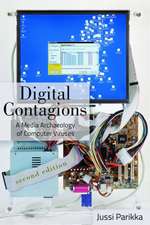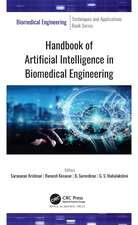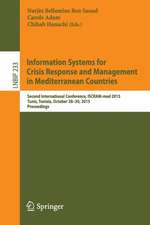Routledge Handbook on Information Technology in Government
Editat de Yu-Che Chen, Michael J. Ahnen Limba Engleză Hardback – 24 feb 2017
This Handbook provides a compelling survey of the advanced and emerging innovative applications of information technology in government. Leading experts and academics provide insights from decades of integrating technological innovations in government and the best ways to lead and manage them. This Handbook accomplishes the goal by integrating three featured components: (a) strong focus on cutting-edge innovations; (b) their impact on government administration and core public service values; and (c) their theoretical and practical implications for scholars and public sector professionals. The specifics on each component are as follows.
- The first section examines the innovative practices in the use of information and communication technologies (ICTs) in government and the fast advancements of technologies such as semantic web, social media, social networking sites, big data, internet of things, and smart city and their uses.
- Firmly grounded in the perspective of public administration and management, the chapters in this second section examine how the emerging innovative practices in government are impacting public administration in theory and practice and advancing core public service values. These core values include transparency, accountability, good governance, citizen-centric integrated services, innovations for efficiency, and openness. Governments around the world are arguably the biggest consumers of information and technologies, and their rapid and massive adoption of a recent wave of emerging technologies requires thorough and critical reflection.
- The final section provides enduring policy and management lessons for policy makers, public administrators, as well as information technology managers, for dynamic and yet sustainable innovations with information technology. This Handbook will include a historical review of the use of IT innovations in government and provide theoretical and conceptual frameworks to gain a holistic view of technology in government that will help maintain a system of robust innovations. These chapter contributions will be from experts who have seen various waves of technological innovations, recent and past, and who have practical experience in providing research-based management advice. These time-honored lessons will be relevant for years to come. More importantly, we can utilize them for sustainable innovations.
With its emphasis on innovative electronic governance practices, this Handbook aids in research and teaching in public administration and affairs and for those who need to understand digital governance issues.
| Toate formatele și edițiile | Preț | Express |
|---|---|---|
| Paperback (1) | 429.71 lei 6-8 săpt. | |
| Taylor & Francis – 10 dec 2019 | 429.71 lei 6-8 săpt. | |
| Hardback (1) | 1244.31 lei 6-8 săpt. | |
| Taylor & Francis – 24 feb 2017 | 1244.31 lei 6-8 săpt. |
Preț: 1244.31 lei
Preț vechi: 1747.41 lei
-29% Nou
238.10€ • 249.22$ • 198.17£
Carte tipărită la comandă
Livrare economică 31 martie-14 aprilie
Specificații
ISBN-10: 1138925675
Pagini: 416
Ilustrații: 72
Dimensiuni: 178 x 254 x 23 mm
Greutate: 0.84 kg
Ediția:1
Editura: Taylor & Francis
Colecția Routledge
Locul publicării:Oxford, United Kingdom
Public țintă
Postgraduate and UndergraduateCuprins
Chapter 1: The Promises and Opportunities of Information Technology in Government
Section I: Theories of Information Technology (IT) Innovations in Government
Chapter 2: Transforming Government Services over Time: Meanings, Impacts, and Implications for Citizen – Government Relationships
Chapter 3: Information Policies: Value-oriented, Instrumental and Managerial Choices for Governing an Information Society
Chapter 4: An Integrative Framework for Effective Use of Information and Communication Technologies (ICTs) for Collaborative Public Service Networks
Chapter 5: Using System Dynamics for the Analysis of Complex Social Problems and Public Policy Alternatives: Fundamentals and Recommendations
Section II: Emerging Technologies and Their Applications for Government
Chapter 6: Big data and local performance management: the Experience of Kansas City, Missouri
Chapter 7: Mobile Location Based Service (LBS) Apps for Public Sector: Prospects and Challenges
Chapter 8: Internet of Things for Public Service: Innovative Practice in China
Chapter 9: Big Data Analysis on Public Opinion: A Case Study on the Policy Formation of Free Economic Pilot Zones in Taiwan
Section III: Technology-enabled Cross-boundary Collaboration and Governance
Chapter 10: Citizen Trust in Government as a Two-way Process: The Role of Government Performance, E-Government and Citizen Attributes
Chapter 11: Social Media Communication Modes in Government
Chapter 12: Resident-Government Engagement via New Technologies
Chapter 13: Civic Hacking: Citizens Creating New Digital Government Interfaces
Section IV: Advancement of Democratic Accountability and Public Values
Chapter 14: Catching On and Catching Up: Developments and Challenges in E-Participation in Major U.S. Cities
Chapter 15: Navigating the Open Government Comfort Zone for the Effective Use of Open Data
Chapter 16: Technology, Transparency, and Local Government: Assessing the Opportunities and Challenges
Chapter 17: Protection of Personally Identifiable Information in Government: A Survey of US Regulatory Framework and Emerging Technological Challenges
Chapter 18: An Exploratory Study of E-participation Technology Adoption by Citizens
Section V: Advancement of Public Service through Technological Innovations
Chapter 19: Providing Critical Emergency Communications via Social Media Platforms: Multiple Case Study
Chapter 20: An Analysis of Main Attributes for Governance in Smart Cities
Chapter 21: Cyberinfrastructure for Collaborative Scientific Networks: Institutional Design and Management Strategies
Chapter 22: E-Government in China
Chapter 23: E-government Innovations in South Korea: Lessons from the Leading E-government Nation
Conclusion
Chapter 24: Conclusion – The Future of Information Technology and Government
Notă biografică
Michael J. Ahn is an assistant professor of public policy and public affairs in UMass Boston’s McCormack Graduate School of Policy and Global Studies. His research interests include: digital government, technological innovations in government, public policy communication, and public affairs education. Michael’s current research projects on digital government focus on topics such as civic technology, smart city, technology-enabled government call centers, social media use in government, and the effectiveness of IT training in public administration programs.
Recenzii
'Ubiquitous computing means the transformation of government for the information age. This volume brings together a wide range of expert research and reflections on innovative practice across the spectrum of digital government. It covers issues from smart cities to emergency management, from citizen participation to hacking, and includes conceptual frameworks as well as detailed case studies. It brings the reader a bird’s eye view of the current state of play regarding information technology in government. Every serious researcher will want to consult this volume'. – Jane Fountain, University of Massachusetts Amherst and National Center for Digital Government
'IT remains underemphasized in government. Finally, an invaluable source taking a comprehensive view on this topic. Governments are information intensive by nature. This book contains amazing insights from theory, stories and cases. IT is at the very heart of government functioning. Advancing this requires combining theoretical and practical insights which are covered in this book.' - Marijn Janssen, Delft University of Technology
'Ubiquitous computing means the transformation of government for the information age. This volume brings together a wide range of expert research and reflections on innovative practice across the spectrum of digital government. It covers issues from smart cities to emergency management, from citizen participation to hacking, and includes conceptual frameworks as well as detailed case studies. It brings the reader a bird’s eye view of the current state of play regarding information technology in government. Every serious researcher will want to consult this volume'. – Jane Fountain, University of Massachusetts Amherst and National Center for Digital Government
'In summary, I find this book very informative. It includes many topical subjects that simply are not found in most books. This book provides an excellent overall summary, and compiles a lot of world-class thinking about delivering information technology in to governments. For that reason is an excellent reference in addition to being a high quality text useful for civic and government studies where technology and techno-social issues are being discussed. This book can serve as the basis for beginning many discussions and for providing training and education in government information technology needs and approaches. In my view, this is essential reading and readers will learn a lot from it.' - Jeff Thurston, 3D Visualization World Magazine
Descriere
This Handbook provides a compelling survey of the advanced and emerging innovative applications of information technology in government. Leading experts and academics provide insights from decades of integrating technological innovations in government and the best ways to lead and manage them. This Handbook accomplishes the goal by integrating three featured components: (a) strong focus on cutting-edge innovations; (b) their impact on government administration and core public service values; and (c) their theoretical and practical implications for scholars and public sector professionals. The specifics on each component are as follows.
- The first section examines the innovative practices in the use of information and communication technologies (ICTs) in government and the fast advancements of technologies such as semantic web, social media, social networking sites, big data, internet of things, and smart city and their uses.
- Firmly grounded in the perspective of public administration and management, the chapters in this second section examine how the emerging innovative practices in government are impacting public administration in theory and practice and advancing core public service values. These core values include transparency, accountability, good governance, citizen-centric integrated services, innovations for efficiency, and openness. Governments around the world are arguably the biggest consumers of information and technologies, and their rapid and massive adoption of a recent wave of emerging technologies requires thorough and critical reflection.
- The final section provides enduring policy and management lessons for policy makers, public administrators, as well as information technology managers, for dynamic and yet sustainable innovations with information technology. This Handbook will include a historical review of the use of IT innovations in government and provide theoretical and conceptual frameworks to gain a holistic view of technology in government that will help maintain a system of robust innovations. These chapter contributions will be from experts who have seen various waves of technological innovations, recent and past, and who have practical experience in providing research-based management advice. These time-honored lessons will be relevant for years to come. More importantly, we can utilize them for sustainable innovations.
With its emphasis on innovative electronic governance practices, this Handbook aids in research and teaching in public administration and affairs and for those who need to understand digital governance issues.


























